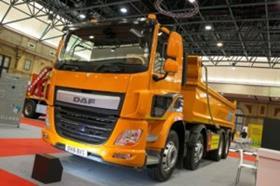Freight in the City (FitC) caught up with Phil Moon, marketing manager at Daf Trucks, at the expo to discuss London's proposed Direct Vision Standard and its potential implications for hauliers.
FitC: On display you have a Daf CF low-height 8×4 rigid tipper fitted with a ClearView passenger door window, what other features does it have making it suited to urban delivery?
Moon: It’s got a camera system, warnings, filled in sideguards. But the fundamental design change is that the truck is not an NG3, it’s an N3, so it sits a bit lower. About six inches lower than the majority of 8-wheelers that we’d sell today and in the past.
This brings us to the forthcoming Direct Vision Standard, which has been discussed at length at the expo today. What are Daf's thoughts on it?
I have some concerns from an operators’ perspective. A lot of the focus has been on construction vehicles. Most manufacturers base their construction chassis around a mid-range cab anyway. So although the sort of trucks that have been identified as probably not getting any stars are N3G tippers it may be the case that a lot of higher cabs, longer distance tractors, may also fall into the same category.
That could have a real impact on major national and international fleets that do have to come into London to deliver. I’m not sure that really been appreciated as a knock on effect.
And it's not a long time frame to introduce new vehicle models, I guess?
Yes, 2020 is a relatively short time-period away. An eight wheeler operator could well keep a vehicle for up to eight years. And to potentially ban that vehicle from London in less than four years’ time could be quite dramatic.
And there’s still uncertainty [in regards who will be conducting the Direct Vision audits for TfL and when]. So I think there’s a possibility that operators won’t be able to understand what a truck’s star rating might be until earlier into 2017 [so there’s a time issue].
That's potentially quite the headache in regards planning for operators.
Fleet procurement, fleet replacement, what they [operators] can do with vehicles that they think aren’t going to be compliant by 2020; I think that on top of bringing forward the ULEZ, which yes we’ve known what the objective is but the scale of it and the timing of it has changed, puts an awful lot on to hauliers. As an industry that could be a real challenge and ultimately could impact on the cost of transport.

Do you sell enough trucks into London and the surrounding area to make a model exclusively for it to meet Direct Vision?
Like any European, or even global manufacturer, in order to build trucks as cost effectively as we do we rely on a large market. There's obviously diversity in all the markets we sell to but we try to do that out of a toolbox of different components and with a relatively small market when you take the European market as a whole it will be very challenging to do that in a cost effective and a timely way.
And the projected time is very short term. In terms of the gestation cycle and the development cycle for new vehicles, and particular new vehicle concepts you shouldn’t underestimate the implications of producing for instance a low-entry cab it’s quite dramatic.
Is a low entry cab the be all and end all?
When we design trucks we have to take into account a number of different aspects according to the operation. Off road ability might be one for construction. Ease of entry and access might be another one for distribution, there’s lots of different aspects.
Whilst a low entry cab might improve direct vision there are a lot of knock on consequences and disadvantages. It might be suitable for certain types of application if you’re in a multi-drop urban environment but they may not be apparent. As soon as you start to use that vehicle on long distance haulage, which you’d have to if you were bringing goods from the North of England to the South, then how would you accommodate that? There’s no sleeper cab facility, there’s no power train options available to power a 44-tonne vehicle.
So it's not one size fits all then?
Operators need a degree of flexibility. Where they haven’t got flexibility they maybe have to make sure they have dedicated use that they can make sure they can utilise that vehicle as much as possible. If there are restrictions that means you can’t use it in a certain area or you can’t use the vehicle it could be quite impactful.











